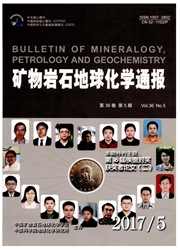

 中文摘要:
中文摘要:
为探讨皖中沙湖山金铅锌矿床矿体中金的赋存状态及其分布形式,对一号矿体的矿石开展了电子显微镜背散射图像观察和能谱分析,以及钻孔岩心多元素含量分析。结果表明,54勘探线2个钻孔中的矿物组合及金的赋存状态均存在一定差异。ZK5403钻孔中矿物组合为黄铁矿、闪锌矿-方铅矿、毒砂-石英,其中Au可能以超微米级或者纳米级的碲化物形式分布于黄铁矿-闪锌矿-方铅矿中,最晚期的毒砂中不含金。而ZK5404中的金矿体则发育在泥质粉砂岩中的黄铁矿细脉中,矿物组合为黄铁矿-石英,基本不含铅锌矿;Au则以显微可见的微米级碲化物形式分布于黄铁矿粒间或包裹于黄铁矿内部。根据金银碲化物的存在,认为成矿热液应为中低温,且具有较高的碲逸度和较低的硫逸度。
 英文摘要:
英文摘要:
In this paper, we studied the gold occurrence of the No. 1 gold orebody at the Guimenguan area in the deposit, by scanning electron microscope BSE observation and EDS analyzing, combing multi-element results from the drill hole. We found that there are some differences in the mineral assemblages and gold occurrences between the two studied drill holes from expl. Line 54. Samples from the drill hole ZK5403 show mineral paragenesis sequence of pyrite, sphalerite-galena and arsenopyrite-quartz. Fine gold grains are probably hosted in pyrite-sphalerite-galena, in the form of submicron or nanometer-scale tellurides; while the late stage arsenopyrite is not the gold hosting mineral. Gold mineralization in the drill hole ZK5404 occurred in the vein-type pyrite, with mineral assemblages of pyrite-quartz, rather than sphalerite-galena. Au are observed by electron microscope, occurred interior of pyrite granules or between pyrite granules. Consequently, the existence of Au-Ag telluride indicate that the ore-forming fluids of Shahushan Au-Pb-Zn deposits are with low temperature, low sulfur fugaeities and high tellurium fugacities.
 同期刊论文项目
同期刊论文项目
 同项目期刊论文
同项目期刊论文
 期刊信息
期刊信息
